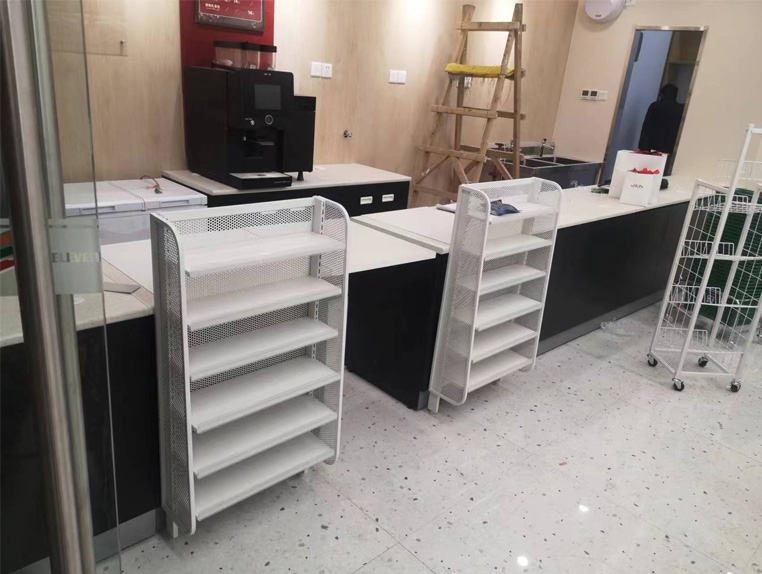You Are Here:Home > Information dynamics
> Industry dynamics
NEWS CENTER
Recommended news
- Where are the customized display shelves mainly used
- How to promote commodity sales on the shelves of wanghong snack shop
- What are the applications of medium-sized storage shelves in logistics centers
- What are the main uses of lightweight storage shelves
- How is the display effect of the island shelves in the mother and baby area
Recommended products
What are the characteristics of vegetable and fruit racks
source:www.hanming.net.cn | Release time:2024-12-03
Vegetable and fruit racks are widely used in supermarkets, fruit shops, farmers' markets, and other places, with the following characteristics:
1. In terms of display functions
Good display effect: Vegetable and fruit racks usually adopt an open design, with a multi-layer structure that can fully display various vegetables and fruits. Customers can easily see the types, colors, sizes, etc. of fruits and vegetables at a glance, making it convenient for them to choose. For example, in a supermarket, rows of neatly arranged vegetable and fruit racks with colorful fruits and fresh vegetables can attract customers' attention and stimulate their desire to consume.
The display methods are flexible and diverse: the height and spacing of the shelves can be adjusted according to the size and display needs of the fruits and vegetables. You can place larger watermelons, pumpkins, etc. on the bottom layer, and small fruits and vegetables such as strawberries and blueberries on the top layer. Moreover, various display methods such as stacking and hanging can also be used. For example, bananas can be hung on specialized hooks to maintain their natural shape and extend their storage time; Apples, oranges, and other fruits can be stacked in layers for easy access by customers.
2. In terms of storage and preservation functions
Good ventilation: The design of the vegetable and fruit rack emphasizes ventilation and breathability. Shelves are generally made of metal grids or wooden or plastic materials with gaps, which can ensure good air circulation around fruits and vegetables. Good ventilation can reduce the decay and deterioration of fruits and vegetables caused by local high temperatures and humidity, and extend the shelf life of fruits and vegetables. For example, a well ventilated environment on the vegetable and fruit shelves in a farmer's market helps keep vegetables fresh.
Easy to classify and store: Different types of fruits and vegetables have different storage requirements, and the fruit and vegetable rack can be partitioned and stored according to these requirements. For example, placing leafy vegetables in one area and root vegetables in another area; Separate tropical and temperate fruits for storage, etc. This classified storage helps meet the specific storage needs of fruits and vegetables, further extending their shelf life.
3. In terms of practicality
Moderate carrying capacity: Vegetable and fruit racks need to have a certain carrying capacity to support the weight of vegetables and fruits. It can carry various weights of fruits and vegetables, from lighter strawberries and blueberries to heavier winter melons, durians, etc. Its structure has been designed to ensure stability and safety under normal fruit and vegetable display weight, without easily deforming or damaging.
Easy to clean and maintain: Due to the possibility of juice leakage and dust contamination during storage and sales of fruits and vegetables, the vegetable rack needs to be easy to clean. The material is generally chosen to be smooth and corrosion-resistant, such as stainless steel, plastic, etc., so that it can be easily wiped or rinsed during cleaning. Moreover, the structure of the vegetable and fruit rack is simple, without too many complex components, making it easy for daily maintenance and repair.
4. In terms of space utilization
High space utilization: The multi-layered design of the vegetable and fruit rack can fully utilize vertical space to display and store more vegetables and fruits within a limited store area. Moreover, it can be flexibly combined and placed according to the layout and space size of the store. For example, it can be placed against the wall or arranged in an island shape in the middle of the store to make full use of the space.
1. In terms of display functions
Good display effect: Vegetable and fruit racks usually adopt an open design, with a multi-layer structure that can fully display various vegetables and fruits. Customers can easily see the types, colors, sizes, etc. of fruits and vegetables at a glance, making it convenient for them to choose. For example, in a supermarket, rows of neatly arranged vegetable and fruit racks with colorful fruits and fresh vegetables can attract customers' attention and stimulate their desire to consume.
The display methods are flexible and diverse: the height and spacing of the shelves can be adjusted according to the size and display needs of the fruits and vegetables. You can place larger watermelons, pumpkins, etc. on the bottom layer, and small fruits and vegetables such as strawberries and blueberries on the top layer. Moreover, various display methods such as stacking and hanging can also be used. For example, bananas can be hung on specialized hooks to maintain their natural shape and extend their storage time; Apples, oranges, and other fruits can be stacked in layers for easy access by customers.
2. In terms of storage and preservation functions
Good ventilation: The design of the vegetable and fruit rack emphasizes ventilation and breathability. Shelves are generally made of metal grids or wooden or plastic materials with gaps, which can ensure good air circulation around fruits and vegetables. Good ventilation can reduce the decay and deterioration of fruits and vegetables caused by local high temperatures and humidity, and extend the shelf life of fruits and vegetables. For example, a well ventilated environment on the vegetable and fruit shelves in a farmer's market helps keep vegetables fresh.
Easy to classify and store: Different types of fruits and vegetables have different storage requirements, and the fruit and vegetable rack can be partitioned and stored according to these requirements. For example, placing leafy vegetables in one area and root vegetables in another area; Separate tropical and temperate fruits for storage, etc. This classified storage helps meet the specific storage needs of fruits and vegetables, further extending their shelf life.
3. In terms of practicality
Moderate carrying capacity: Vegetable and fruit racks need to have a certain carrying capacity to support the weight of vegetables and fruits. It can carry various weights of fruits and vegetables, from lighter strawberries and blueberries to heavier winter melons, durians, etc. Its structure has been designed to ensure stability and safety under normal fruit and vegetable display weight, without easily deforming or damaging.
Easy to clean and maintain: Due to the possibility of juice leakage and dust contamination during storage and sales of fruits and vegetables, the vegetable rack needs to be easy to clean. The material is generally chosen to be smooth and corrosion-resistant, such as stainless steel, plastic, etc., so that it can be easily wiped or rinsed during cleaning. Moreover, the structure of the vegetable and fruit rack is simple, without too many complex components, making it easy for daily maintenance and repair.
4. In terms of space utilization
High space utilization: The multi-layered design of the vegetable and fruit rack can fully utilize vertical space to display and store more vegetables and fruits within a limited store area. Moreover, it can be flexibly combined and placed according to the layout and space size of the store. For example, it can be placed against the wall or arranged in an island shape in the middle of the store to make full use of the space.
Previous:
Where are heavy storage shelves mainly used
Next:
What are the characteristics of wood grain transf…
【Related Products】
Consultation hotline0512-52436990

- Product series
- Storage shelves
- Supermarket shelves
- Scenario display
- Supermarket shelves
- Cashier
- Wall shelf
- product display
- other parts
- product display
- Kitchen supplies
- Cleaning supplies
- Fruit and vegetable food
- Maternal and Child Home Furnishings
- About Us
- Website homepage
- About Us
- Contact Us
- News Center
- MESSAGE
 WeChat:
WeChat:










 home
home
 WeChat
WeChat
 telephone
telephone